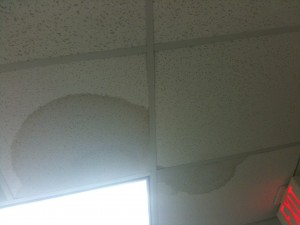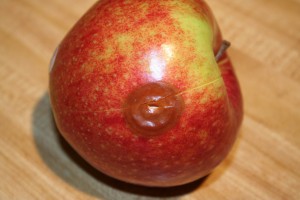Sorry for the late Friday musing post due to a trip to South Caroline for a wedding. That adventure (including a foray to my old stomping ground at the South Carolina Botanical Gardens will be for another Friday. Friday musings better late than never…
Two Fridays ago, I was greeted upon entering the Plant Clinic with a wet lobby and a soaked secretary table. Looking up, I could see where the water infiltrated our lobby. I sent Bobbi, our Technical Secretary upstairs to see if the folk had a similar problem or they left a faucet on (grr.. happened before). All we got were blank stares and no evidence of any water seepage. Apparently, this will take a bit more detective work. Thankfully, we were informed not too long later that the building manager had been called by the cleaning crew the previous evening when the “waterfall” began. And the problem was several leaks in the roof. The roof!!!!…but the 2nd floor was dry as a bone? The building guys had to remove the ceiling tile and climb up to see how the water moved and chose to “fall into” our lobby. Initial assessment based of the symptom of wet ceiling tile, desk and floor was insufficient to tell the whole story.
To some degree, the daily events at the Plant Clinic are similar. We get submissions daily and many times it is only part of the plant. We always hope to gain great background information for the submission form, but this is not always the case. A quick triage usually helps us to separate the bad from the worse. We get to work as quickly as possible on the worse. There have been many times that we report that the sample was bad and occasionally request the submitter to remit a new sample. Pathogens and causes for plant problems are tricky things. Usually they hide from our eyes. After a quick deep breath, Sheila the diagnostician will begin to “peel” away the layers to find out the true cause of the problem. Every bit of observed clues from the sample and from the information provided will hopefully help us trace the cause back to the causer! Sometimes this can be quick, but many times this is a tedious process that may entail preparing the sample for additional procedures such as ELISA testing or isolation culturing. Like the leak symptom on the roof, an obvious disease symptoms might just not be so obvious.
Just remember that if you are affected with problematic plants – stay calm, look at the plant and look around. Look for things that may be contributing to the symptoms that are seen. Be prepared to look beyond the obvious symptoms to get to the true cause of the problem.




